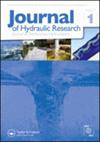Bed morphology adjustment under the impact of a near-bank emergent model vegetation patch
IF 1.7
3区 工程技术
Q3 ENGINEERING, CIVIL
引用次数: 0
Abstract
ABSTRACTThis paper investigated spatial characteristics of bed morphology around a near-bank emergent vegetation patch. Experimental results showed that patch length and density impacted the spatial scale, orientation and type of pool-bar morphology around the patch. Adjacent to the patch, the pool onset lowest location tended to move upstream as patch length and density increased, quantitatively described by a power function involving the two factors; the transverse bed topography along the pool was described by a two-zone scaling model, providing prediction models for the pool morphology, particularly for narrow urban channels. Moreover, we identified, in the patch wake, two types of bars formed meditated by patch length. Short-point and elongated bars formed under short and long patches, respectively, attributed to different mechanisms of flow–sediment-patch interaction, offering new insights into wake depositional trends and streamwise vegetation succession during different vegetation growth stages. The gained knowledge is useful for vegetation-based urban channel restoration.KEYWORDS: Flow–sediment–vegetation interactionnear-bank vegetation successionpool-bar morphologysecondary flowssimilarity in bed topography Supplemental dataSupplemental data for this article can be accessed online at https://doi.org/10.1080/00221686.2023.2241844.Data availabilityMost figures can be generated from data deposited at https://doi.org/10.5281/zenodo.4993413Disclosure statementNo potential conflict of interest was reported by the author(s).Additional informationFundingThis research was partially supported by the National Natural Science Foundation of China (nos. 52239006 and 51909178), the Fundamental Research Funds for the Central Universities, Sichuan University (2020SCU12064) and the RGC project (Polyu 152743/16E), Hong Kong; The research project from the Hong Kong Polytechnic University; CRSRI Open Research Program.近岸应急模式植被斑块影响下的河床形态调整
摘要本文研究了近岸突发性植被斑块周围床层形态的空间特征。实验结果表明,斑块长度和密度影响斑块周围池坝形态的空间尺度、方向和类型。在斑块附近,随着斑块长度和密度的增加,池的起始最低位置有向上游移动的趋势,这可以用涉及这两个因素的幂函数来定量描述;两区尺度模型描述了沿池的横向河床地形,为池的形态提供了预测模型,特别是对于狭窄的城市河道。此外,我们还发现,在斑块尾迹中,斑块长度可以形成两种类型的条纹。在短斑块和长斑块下形成的短点沙洲和细长沙洲分别归因于不同的流沙斑块相互作用机制,为研究不同植被生长阶段尾流沉积趋势和沿河植被演替提供了新的思路。所获得的知识对基于植被的城市河道恢复是有用的。关键词:流-沉积-植被相互作用近岸植被演替池坝形态次级流河床地形相似性补充数据本文补充数据可在https://doi.org/10.1080/00221686.2023.2241844.Data available网站上获取大部分数据可从https://doi.org/10.5281/zenodo.4993413Disclosure statement网站上的数据生成作者未报告潜在利益冲突。本研究得到国家自然科学基金(no . 52239006和51909178)、四川大学中央高校基本科研业务费专项资金(no . 2020SCU12064)和香港理大152743/16E项目的部分资助;该研究项目来自香港理工大学;CRSRI开放研究计划。
本文章由计算机程序翻译,如有差异,请以英文原文为准。
求助全文
约1分钟内获得全文
求助全文
来源期刊

Journal of Hydraulic Research
工程技术-工程:土木
CiteScore
4.90
自引率
4.30%
发文量
55
审稿时长
6.6 months
期刊介绍:
The Journal of Hydraulic Research (JHR) is the flagship journal of the International Association for Hydro-Environment Engineering and Research (IAHR). It publishes research papers in theoretical, experimental and computational hydraulics and fluid mechanics, particularly relating to rivers, lakes, estuaries, coasts, constructed waterways, and some internal flows such as pipe flows. To reflect current tendencies in water research, outcomes of interdisciplinary hydro-environment studies with a strong fluid mechanical component are especially invited. Although the preference is given to the fundamental issues, the papers focusing on important unconventional or emerging applications of broad interest are also welcome.
 求助内容:
求助内容: 应助结果提醒方式:
应助结果提醒方式:


